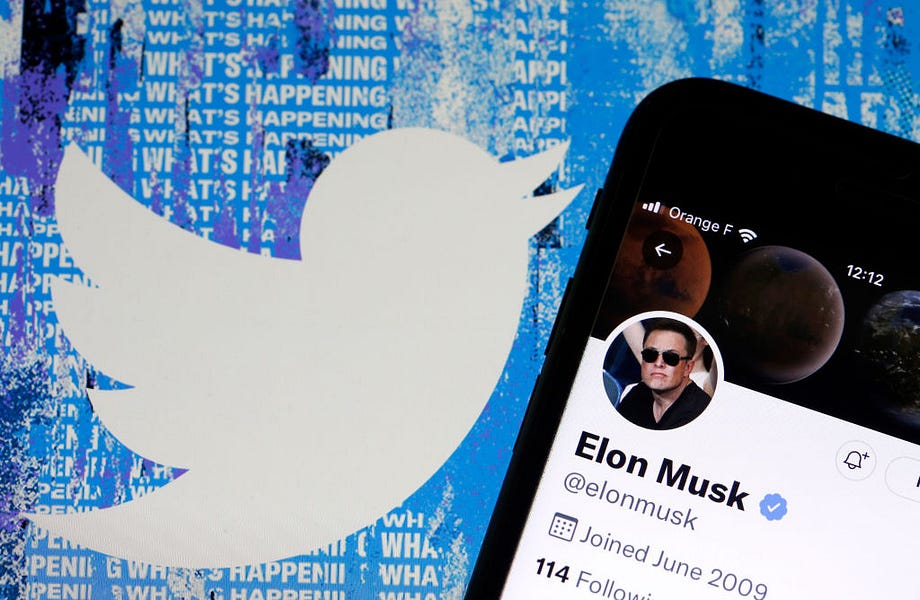Hello, and happy Thursday! On this day in 2003, Apple launched its iTunes Store, giving users the ability to buy and download music directly to their personal library. Since then, more than 25 billion songs have been downloaded and the entire music industry has been transformed.
Today’s newsletter is a bit of a hodgepodge, with a few suggestions on how Elon Musk can make Twitter less of a dumpster fire, an explanation of why Ukraine’s request for more powerful drones is actually kind of complicated, a story about how a private company is using purchased data to track American spies, and we wrap it all up with a cool video on how bacteria are being hacked to fight cancer. Let’s get to it.
Thoughts on Elon’s Purchase of Twitter
So it looks like we’re doing this. Twitter’s board is recommending that the company’s shareholders accept Elon Musk’s offer to buy the social media company for $44 billion—now it’s time to dot the “i” and cross the “t.” This, of course, has the twitterati on both the political left and the right hyperventilating, and I’m just kind of over the whole thing.
Time will tell what changes will come but I’m just not expecting anything too significant. Twitter isn’t going to have a pure First Amendment standard for content because—as Truth Social, Parler, Gab, and others have proven—it’s too risky from a liability standpoint and consumers don’t want it. What consumers really want is speech THEY like and everyone else can go hang. Therefore, we’ll see some change (perhaps even some improvements) on the margins but I’m pretty sure everyone expecting a categorical shift is going to be disappointed. And it looks like Elon knows this too and is already preparing Twitter’s users for the eventual let down.
That said, there are some things he could do that I’d personally welcome.
-
Get rid of the bots. Only verified humans should be allowed to have accounts and tweet.
-
Get rid of the porn. The internet has plenty (too much) porn and, if Twitter really is going to be “the new public square,” then let’s clean the place up a bit.
-
Get rid of, or greatly constrain, accounts representing autocratic leaders, governments, or institutions. If they are currently practicing genocide or mass human rights violations, they shouldn’t be on the platform. If a government will not allow its citizens to download and use Twitter, the company should not respond by allowing this same government to manipulate Twitter and its users for the purposes of propaganda or otherwise extending that government’s influence.
-
Stealing an idea from AEI colleague Yuval Levin, Twitter should also have professional channels where everyone can listen but only verified experts can contribute. I understand the whole “who gets to be an expert” argument but we can figure that out. Of course, anyone would still be able to share their opinions on whatever topic they like in the main Twitter feed; but it’d be nice to have the option of tuning into a channel about economics, foreign policy, cancer research, golf, or whatever where the discussion is being carried by people who engage these issues for a living.
-
Oh, and of course, give us the ability to edit a post so that I’m never stuck with a Tweet that says, “Everyone keeps complimenting me on the smell of my new colon.”
Ukraine Wants to Level-Up Its Drones
Ukraine is requesting the United States provide it with advanced “strike drones,” according to Politico. Specifically, Kyiv has its eyes on the U.S- made MQ-9 Reaper and MQ-1C Gray Eagle remotely piloted aircraft—both of which are among the most lethal and proven drones in the American arsenal.
Ukraine has already used the Turkish-made TB2 to great effect.The United States is currently sending thousands of Switchblade “suicide drones” and is even reportedly fast-tracking a new drone for Ukraine called the Phoenix Ghost. But sending Reapers and Gray Eagles would be a significant move.
Both drones can fly much farther, much higher, and for much longer than anything currently available to President Volodymyr Zelensky. The appeal of these systems is obvious: As the fight in Ukraine shifts to the Donbas and increasingly focuses on dislodging a consolidated Russian force, these systems would allow the imperiled nation’s military to rain down significant firepower from a much more defensible distance. Their advanced avionics and sensors would likewise improve Ukraine’s joint operations and intelligence capabilities. And, unlike the Switchblades and Phoenix Ghosts, these drones are reusable and can carry larger ordinance like the AGM-114 Hellfire missile (a tank killer missile).
When asked about the request, Pentagon spokesperson John Kirby demurred, saying, “When there are decisions to announce and to speak to about capabilities that we’re going to provide Ukraine, we will certainly do that.”
While I’m all for helping Ukraine turn this invasion into a Russian meat grinder, there are serious issues at stake in this decision. Both systems, for example, are managed under the Missile Technology Control Regime (MTCR), which means the U.S. State Department and Department of Defense must sign-off on their export, but with a “strong presumption of denial.” And there are good reasons for these controls.
First, there’s the technology itself. These systems give the United States meaningful tactical advantage, but this advantage gets diluted as the systems proliferate to other nations. There’s also concerns about the Ukrainian military’s ability to use these advanced drones. While the remote pilot stations may look like a fancy video game setup, advanced drones require real expertise and even other advanced technologies to be used to their fullest. Finally, there should also be some concern about Ukraine using these systems too well. Both drones could fly well into Russian territory and be used to strike targets there. While there have been some “fires” at several Russian fuel depots near the Ukrainian border, a strike inside of Russia using an American-provided drone could introduce more risks of escalation.
In the end, I don’t get frustrated when Ukrainians keep asking for more—they’re fighting for their lives and homes, and I’d do the same thing. But it’s possible for the United States to be a good friend to Ukraine while not granting every request. I won’t be sad if we give them Reapers and Gray Eagles, but I also won’t be mad if we don’t.
A Private Company Spied on American Spies Using Data Anyone Can Purchase
Anomaly Six (A6), a Virginia-based open source intelligence company, says it can provide real-time monitoring of billions of mobile phones using nothing more than data anyone can buy, according to The Intercept. While other companies make similar claims, A6 recently looked to prove its capabilities by spying on employees at the CIA and NSA.
The company was reportedly able to identify 183 phones that had visited both agencies, suggesting the owners were almost assuredly members of the U.S. intelligence community. As part of this demonstration, A6 was able to follow one of these handsets around the United States and to a training center and airbase in Jordan, where a fleet of U.S. drones is thought to be stationed. Back in the United States, the company was able to identify this person’s home and other frequently visited locations. But it gets even worse.
Using a tweeted satellite photo of the USS Dwight D. Eisenhower aircraft carrier in the Mediterranean Sea, A6 was able to extract a timestamp and the latitude and longitude coordinates of the ship from the picture, and then look for a mobile phone pinging from that location at that time. They found one and, looking at that device’s GPS history, were able to see the ship’s transit all the way back to Norfolk, Virginia.
Fortunately, A6 isn’t working with foreign governments but everything they’ve done could easily be (and likely is being) repeated by our adversaries. How is this possible, you may ask. It’s all about mobile advertising.
Virtually all mobile apps use common software development kits (SDKs) that allow them to easily monetize their offerings using ads. These SDKs use information like a phone’s GPS history to serve up ads based on a user’s location, shopping habits, or other “patterns of life.” A6 has supposedly partnered with “thousands” of app makers to buy this information and use it for its own intelligence as a service offerings. According to The Intercept’s story:
A6 claims that its GPS dragnet yields between 30 to 60 location pings per device per day and 2.5 trillion locational data points annually worldwide, adding up to 280 terabytes of location data per year and many petabytes in total, suggesting that the company surveils roughly 230 million devices on an average day. A6’s salesperson added that while many rival firms gather personal location data via a phone’s Bluetooth and Wi-Fi connections that provide general whereabouts, Anomaly 6 harvests only GPS pinpoints, potentially accurate to within several feet. In addition to location, A6 claimed that it has built a library of over 2 billion email addresses and other personal details that people share when signing up for smartphone apps that can be used to identify who the GPS ping belongs to.
Nothing A6 claims to be able to do is illegal. Most app terms of service make it clear that developers can do whatever they want with the data they collect—including selling it to third parties. While this data is often “anonymized,” it doesn’t take much to figure out where a person lives based on their GPS history and then to identify everyone living at that address. And here’s the crazy part: This isn’t anywhere near the creepiest stuff that can be done with this information (I won’t be giving anyone any ideas.) The sad truth is that this data horse is so far outside of the barn that I’m not sure we’ll ever get it back. But this makes it even more important that the United States start thinking more carefully about the national security implications of our private data markets, because I guarantee our global rivals are.
Closing on a High Note
If that last story left you frustrated or freaked out, how ‘bout a little mental palate cleanser? I know this tech stuff can feel scary and I’m always mindful of not wanting to be a constant source of fear or stress. To that end, I think it’s helpful to remember that, with all its attendant challenges, technology is also a source of growing human thriving and potential. Here’s a short video on how we’re hacking bacteria to fight cancer—a technological advancement that is literally saving lives.
That’s it for this edition of The Current. Be sure to comment on this post and to share this newsletter with your family, friends, and followers. You can also follow me on Twitter (@KlonKitchen). Thanks for taking the time and I’ll see you next week!







Please note that we at The Dispatch hold ourselves, our work, and our commenters to a higher standard than other places on the internet. We welcome comments that foster genuine debate or discussion—including comments critical of us or our work—but responses that include ad hominem attacks on fellow Dispatch members or are intended to stoke fear and anger may be moderated.
With your membership, you only have the ability to comment on The Morning Dispatch articles. Consider upgrading to join the conversation everywhere.